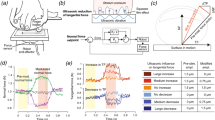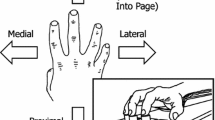Abstract
The purpose of this study was to identify the influence of a high- and low-friction surface on the ability to maintain a steady downward force during an index finger pressing and moving task. Fifteen right-handed subjects (24–48 years) performed a static force pressing task and a hybrid pressing and moving task on the surface of an iPad mini while holding a steady 2-N force on high- and low-friction surfaces. Variability of force was quantified as the standard deviation (SD) of normal force (F z) and shear force (F xy) across friction conditions and tasks. The SD of F z was 227 % greater during the hybrid task as compared to the static task (p < .001) and was 19 % greater for the high- versus low-friction condition (p = .033). There were positive correlations between SD of F z and F xy during the hybrid force/motion tasks on the high- and low-friction conditions (r 2 = 0.5 and 0.86, respectively), suggesting significant associations between normal and shear forces for this hybrid task. The correlation between the SD of F z for static and hybrid tasks was r 2 = 0.44, indicating that the common practice of examining the control of static tasks may not sufficiently explain performance during hybrid tasks, at least for the young subjects tested in the current study. As activities of daily living frequently require hybrid force/motion tasks (e.g., writing, doing the dishes, and cleaning counters), the results of this study emphasize the need to study motor performance during hybrid tasks in addition to static force tasks.




Similar content being viewed by others
References
Bizzi E, Accornero N, Chapple W, Hogan N (1984) Posture control and trajectory formation during arm movement. J Neurosci 4:2738–2744
Bobjer O, Johansson SE, Piguet S (1993) Friction between hand and handle. Effects of oil and lard on textured and non-textured surfaces; perception of discomfort. Appl Ergon 24:190–202
Carville SF, Perry MC, Rutherford OM, Smith IC, Newham DJ (2007) Steadiness of quadriceps contractions in young and older adults with and without a history of falling. Eur J Appl Physiol 100:527–533. doi:10.1007/s00421-006-0245-2
Chhatbar PY, Francis JT (2013) Towards a naturalistic brain-machine interface: hybrid torque and position control allows generalization to novel dynamics. PLoS One 8:e52286
Chib VS, Krutky MA, Lynch KM, Mussa-Ivaldi FA (2009) The separate neural control of hand movements and contact forces. J Neurosci 29:3939–3947
Cianchetti FA, Valero-Cuevas FJ (2010) Anticipatory control of motion-to-force transitions with the fingertips adapts optimally to task difficulty. J Neurophysiol 103:108–116
Cole KJ, Johansson RS (1993) Friction at the digit-object interface scales the sensorimotor transformation for grip responses to pulling loads. Exp Brain Res 95:523–532
Cole KJ, Rotella DL, Harper JG (1999) Mechanisms for age-related changes of fingertip forces during precision gripping and lifting in adults. J Neurosci 19:3238–3247
Delph MA, Fischer SA, Gauthier PW, Luna CH, Clancy EA, Fischer GS (2013) A soft robotic exomusculature glove with integrated sEMG sensing for hand rehabilitation. IEEE Int Conf Rehabil Robot 2013:6650426
Derler S, Gerhardt L, Lenz A, Bertaux E, Hadad M (2009) Friction of human skin against smooth and rough glass as a function of the contact pressure. Tribol Int 42:1565–1574
Desrosiers J, Bravo G, Hebert R, Dutil E, Mercier L (1994) Validation of the Box and Block Test as a measure of dexterity of elderly people: reliability, validity, and norms studies. Arch Phys Med Rehabil 75:751–755
Desrosiers J, Hebert R, Bravo G, Dutil E (1995) Upper extremity performance test for the elderly (TEMPA): normative data and correlates with sensorimotor parameters. Test d’Evaluation des Membres Superieurs de Personnes Agees. Arch Phys Med Rehabil 76:1125–1129
Desrosiers J, Bravo G, Hebert R (1997) Isometric grip endurance of healthy elderly men and women. Arch Gerontol Geriatr 24:75–85
Flash T, Hogan N (1985) The coordination of arm movements: an experimentally confirmed mathematical model. J Neurosci 5:1688–1703
Harris CM, Wolpert DM (1998) Signal-dependent noise determines motor planning. Nature 394:780–784
Heo S, Lee G (2011) Force gestures: augmented touch screen gestures using normal and tangential force. In: CHI'11 Extended abstracts on human factors in computing systems ACM, pp 1909–1914
Jara CA, Pomares J, Candelas FA, Torres F (2014) Control framework for dexterous manipulation using dynamic visual servoing and tactile sensors’ feedback. Sensors (Basel) 14:1787–1804
Keenan KG, Massey WV (2012) Control of fingertip forces in young and older adults pressing against fixed low- and high-friction surfaces. PLoS One 7:e48193
Keenan KG, Santos VJ, Venkadesan M, Valero-Cuevas FJ (2009) Maximal voluntary fingertip force production is not limited by movement speed in combined motion and force tasks. J Neurosci 29:8784–8789
Keenan KG, Massey WV, Walters TJ, Collins JD (2012) Sensitivity of EMG-EMG coherence to detect the common oscillatory drive to hand muscles in young and older adults. J Neurophysiol 107:2866–2875. doi:10.1152/jn.01011.2011
Kouzaki M, Shinohara M (2010) Steadiness in plantar flexor muscles and its relation to postural sway in young and elderly adults. Muscle Nerve 42:78–87. doi:10.1002/mus.21599
Marmon AR, Pascoe MA, Schwartz RS, Enoka RM (2011) Associations among strength, steadiness, and hand function across the adult life span. Med Sci Sports Exerc 43:560–567
Minsky MR (1984) Manipulating Simulated objects with real-world gestures using a force and position sensitive screen. Comput. Gr 18:195–203
Mizobuchi S, Terasaki S, Keski-Jaskari T, Nousiainen J, Ryynanen M, Silfverberg M (2005). Making an impression: force-controlled pen input for handheld devices. In CHI'05 extended abstracts on Human factors in computing systems ACM, pp 1661–1664
Pang XD, Tan HZ, Durlach NI (1991) Manual discrimination of force using active finger motion. Percept Psychophys 49:531–540
Raibert M, Playter R, Krummel TM (1998) The use of a virtual reality haptic device in surgical training. Acad Med 73:2
Riederer M, Schoenauer C, Kaufmann H, Soechting E, Lamm C (2014) Development of tests to evaluate the sensory abilities of children with autism spectrum disorder using touch and force sensors. In: EAI 4th International Conference on wireless mobile communication and healthcare (Mobihealth), IEEE, pp 160–163
Ruff RM, Parker SB (1993) Gender- and age-specific changes in motor speed and eye-hand coordination in adults: normative values for the Finger Tapping and Grooved Pegboard Tests. Percept Mot Skills 76:1219–1230
Scholz JP, Schoner G (1999) The uncontrolled manifold concept: identifying control variables for a functional task. Exp Brain Res 126:289–306
Seo NJ, Enders LR (2012) Hand grip function assessed by the box and block test is affected by object surfaces. J Hand Ther 25:397–404
Seo NJ, Shim JK, Engel AK, Enders LR (2011) Grip surface affects maximum pinch force. Hum Factors 53:740–748
Shinohara M, Keenan KG, Enoka RM (2005) Fluctuations in motor output during steady contractions are weakly related across contraction types and between hands. Muscle Nerve 31(6):741–750
Sivamani RK, Goodman J, Gitis NV, Maibach HI (2003) Coefficient of friction: tribological studies in man——an overview. Skin Res Technol 9:227–234
Skedung L, Danerlov K, Olofsson U et al (2011) Tactile perception: finger friction, surface roughness and perceived coarseness. Tribol Int 44:505–512
Stein RB, Gossen ER, Jones KE (2005) Neuronal variability: noise or part of the signal? Nat Rev Neurosci 6:389–397
Tomlinson T, Sainburg R (2012) Dynamic dominance persists during unsupported reaching. J Mot Behav 44:13–25
Tomlinson SE, Lewis R, Carre MJ (2009) The effect of normal force and roughness on friction in human finger contact. Wear 267:1311–1318
Valero-Cuevas FJ, Smaby N, Venkadesan M, Peterson M, Wright T (2003) The strength-dexterity test as a measure of dynamic pinch performance. J Biomech 36:265–270
Valero-Cuevas FJ, Venkadesan M, Todorov E (2009) Structured variability of muscle activations supports the minimal intervention principle of motor control. J Neurophysiol 102:59–68
Venkadesan M, Valero-Cuevas FJ (2008) Neural control of motion-to-force transitions with the fingertip. J Neurosci 28:1366–1373
Venkadesan M, Guckenheimer J, Valero-Cuevas FJ (2007) Manipulating the edge of instability. J Biomech 40:1653–1661
Wang Q, Hayward V (2007) In vivo biomechanics of the fingerpad skin under local tangential traction. J Biomech 40:851–860
Wu J, Li L, Yan R, Ni D, Liu W (2012) Experimental study on virtual texture force perception using the JND method. Int J Adv Robot Syst 9:1–9
Author information
Authors and Affiliations
Corresponding author
Rights and permissions
About this article
Cite this article
Joshi, M.N., Keenan, K.G. Force fluctuations while pressing and moving against high- and low-friction touch screen surfaces. Exp Brain Res 234, 1893–1901 (2016). https://doi.org/10.1007/s00221-016-4581-0
Received:
Accepted:
Published:
Issue Date:
DOI: https://doi.org/10.1007/s00221-016-4581-0




